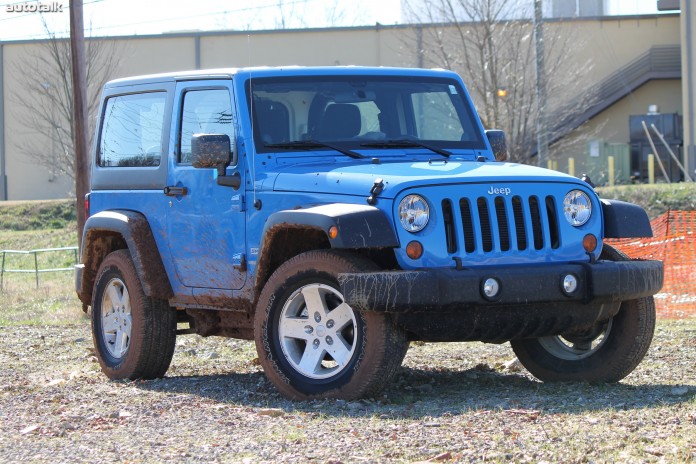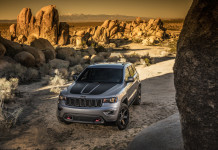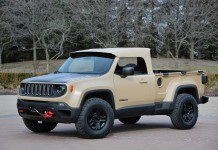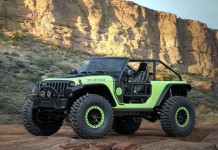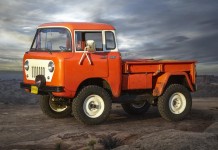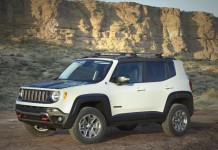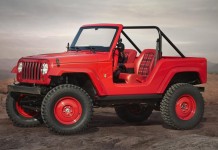Here is a hypothetical situation to consider. You, as both a consumer and commuter have been pulled from the comfort of your pure-city home and placed in the middle of nowhere. In order to get to your place of employment, you must traverse across a myriad of terrains ranging from mud, gravel, loose dirt, fallen trees and fear-inducing rocks. Once out of the woods, you must then travel along the pavement to a small town where you must park with the rest of the masses in a complex. On top of all of this, your wallet isn’t very big and thus, there isn’t much money to spend on something like a Land Rover or Abrams Tank. This situation may seem a tad far-fetched, but it is entirely plausible. Because of this, there must be something inside the automotive industry that has the ability to conquer these tasks and do them with ease. In the 1960s and 1970s, a consumer would have a variety of options to choose from but in 2012, there really is only one still in existence: the Jeep Wrangler.
A Wrangler has been alive, in some shape or form, since the 1940s when the U.S. military needed something that could go anywhere but do it inexpensively. The American armed forces loved the little flat-fendered wonder and to this day, its history is so rich that there are numerous books dedicated just to it. When AMC took custody of the Jeep name and put the heroic CJ series model into production, there wasn’t a muddy trail in the world that hadn’t been tracked by one. Fast forward to today where Chrysler LLC is the proud parents of the namesake and have been since 1987. That year was the first for the Wrangler name, which is now in its third generation. The JK bowed in 2007 with a rounder face, new options, available four doors and a new engine but the same philosophy that the original 1941 Willys held was still present, just slightly modified to stay ‘safe’. A short wheelbase, solid axles front and rear, removable body panels and a unmistakable shape were present and for the most part, things were good but there were a few grips. The largest among them was the engine which at 3.8 liters, was smaller, slower and less torque filled than the smog-unfriendly 4.0 liter straight six it replaced. For the 2012 model year, Chrysler went to silence the complaints as the aging iron-block V6 is gone, replaced with a Ward’s 10 Best Engine winner: the Pentastar V6.
In order to find out just how much of a difference a powertrain swap can make, we got behind the wheel of a two door Wrangler Sport. This is the base trim level and starts out with an MSRP of $22,045 which includes fog lamps, a radio, cruise control and a hill start assist. Added to our Cosmos Blue tester was the 24s package which adds 17 inch wheels, a leather wrapped steering wheel, chrome shift knob and air conditioning. The Connectivity package gives the Wrangler a USB audio port, bluetooth connect with Uconnect voice recognition and a vehicle info display. To get power locks, power windows, keyless entry and heated side view mirrors, the Power Convenience package must be added while a 3-piece hard top gives a rear window wiper, defroster and extra safety. New for 2012 is the $1,125 five speed automatic which replaces the old four speed unit and as before, a six speed manual transmission is still standard. Equipped, our Pentastar-powered tester rolled off the Toledo, Ohio factory floor with a final MSRP of $28,215.



The most substantial change to the 2012 Wrangler can be found under its hood. No longer tired, the Jeep has been given a new lease on life by way of a heart transplant. In the place of the 202 horsepower 3.8 liter iron block V6 which could trace its roots back to 1990, is the all-new corporate Pentastar. At 3.6 liters and using all-aluminum, the DOHC V6 can now be found in 11 Chrysler LLC products and comes in various outputs. For the Wrangler, 285 horsepower and 260 lb-ft of torque is present; a massive 40 percent increase in power. Paired with the optional five speed automatic, the light for its segment two door (3,700 lbs) is no longer considered slow. Introducing the throttle pedal to the firewall can get the Jeep out of the way and do so in a hurry. Acceleration builds rather quickly and the Pentastar, as with other offerings we’ve tested, enjoys being brought to redline. With traction control off, a little bit of brake-torqueing can create the perfect drag strip launch and put a quizzical look on the faces of more than one sports car driver. Off course, due to its low final drive gear ratio and aerodynamically dumb shape, acceleration tends to relax as speed builds. Even still, the Wrangler is more than comfortable cruising at 75 to 80 mph on the highway and doing so will return surprising fuel mileage. We saw 24 mpg on the freeway but in town, the smile-inducing acceleration dropped that number down to an average of 17 mpg.
With the Pentastar in place, any Wrangler could now be considered a hot-rod but that isn’t the only appeal. After all, in our previously mentioned hypothetical situation, pavement is only half of the commute. In order to be a proper Jeep and wear the “Trail Rated” badge with pride, apprehension must not exist when facing a muddy obstacle. With a traditional shift-on-the fly, Command-Trac two speed transfer case, Dana 30 and 44 solid axles front and rear, 8.8 inches of ground clearance and a 95.4 inch wheelbase, the 2012’s running gear and track would make the first Jeeps proud. Activating the added traction is involved but easy. A quick slap into neutral and easy pull on the transfer case shifter is all that is needed to put the truck into four wheel high. This is ideal for loose gravel roads, light slush or low-level trail blazing. For the times when every bit of the Pentastar’s 260 lb-ft of torque is needed, an honestly caveman-like arm movement is needed to initiate the Wrangler’s ‘beast mode”, otherwise known as four wheel low. During our time with the Jeep, we found ourselves in front of a rutted trail that had been beaten the previous two days by torrential rain. Letting the powertrain crawl on its own to get to the entry point, once momentum began to slow a well-placed right foot made quick work of the obstacle. When a tire spinning, Jack Russell-like attack is needed, the five speed auto does a fantastic job of holding the V6 in its optimal torque range: around 4,500 rpms. Visibility is excellent, even out the side rear and the power windows fall fast enough so that true, out the window off roading can be had. There is no doubt that it would take a seriously hazardous obstacle to stop any Wrangler, even the base Sport. With an aftermarket so vast that a person can get lost, a truly unstoppable Jeep can be built in the blink of an eye.
The Wrangler is a historic time capsule and because of its inherent design, no amount of power can quell its hereditary flaws. The use of live axles gives it remarkable suspension articulation and strength but creates a bouncy ride on the road. It is by no means jarring, but hitting speed bumps and or railroad tracks can be felt and heard inside the cabin. Its short wheelbase and tall ride height is great for traversing rocks and fallen trees, but it creates a level of driver anxiety usually reserved for rat-rods and Junkers. Even with its excellently weighted steering wheel, there was a constant voice in the back of our minds that said, “um, this thing could flip really fast.” There is even a friendly warning sign on the sun visor to remind you and put you at “ease” (it actually does the opposite). Another classic Wrangler feature is the ability to remove the doors in under five minutes. As cool as that may be, the doors never once closed fully on the first try and getting into a tall truck without an A-Pillar handle is rather cumbersome. Putting aside the Wrangler’s irreversible flaws, the 2012’s new stuff still isn’t perfect. The throttle is slow to respond and more times than not, the five speed would upshift a little too early for comfort. But when called upon, it always returned a lower gear and high rpm upshifts were never harsh or jarring. It may not the best slushbox on the market, but it is worlds better compared to the outgoing four speed.
As it sits now with its updated running gear, efficient power and more modern drive, the Wrangler is still in a class of its own. It makes no excuses and twists no one’s arms into making them believe it is something that it’s not. Yes, it’s flawed and there is still room for improvement but there comes a point when upgrades go too far. Take the Jeep’s historic competition into consideration and look where those vehicles are now. If a Toyota FJ Cruiser, stout as it may be, tried to follow a Wrangler into a trail, it would get stuck before the Jeep would. A Land Rover may have more electronic traction assists than the Wrangler, but a consumer could buy three Jeeps for the price of one Discovery. Those vehicles have lost sight of what made the light weight, simple off road machine so popular in the first place. Chrysler is not hurting because of the Wrangler’s old-school persona as 2011 saw a 30 percent increase in sales with 122,460 total units sold; and that was with the old 3.8 liter engine. The American automaker is already expecting a higher annual output and has increased its Toledo workforce accordingly. This is a very smart move on Chrysler’s end as with the addition of the Pentastar and the five speed auto, the 2012 model year is the most impressive offering yet. It now has the ability to sling itself through the slickest mud holes, crawl over the most torturous obstacles, climb the biggest hills, and then blast down the highway at rapid speed. And when you arrive at your destination covered in mud and park next to your co-worker’s clean-as-a-whistle FJ, you can rest assured that your small amount of money was well spent on the only true off roader still in existence: the 2012 Jeep Wrangler.

